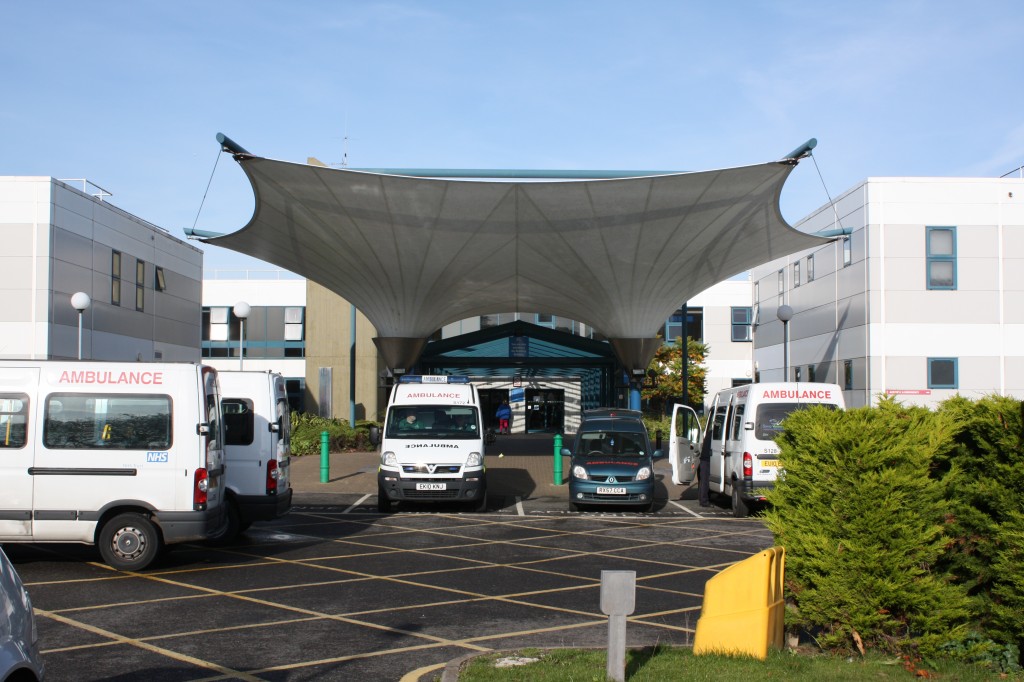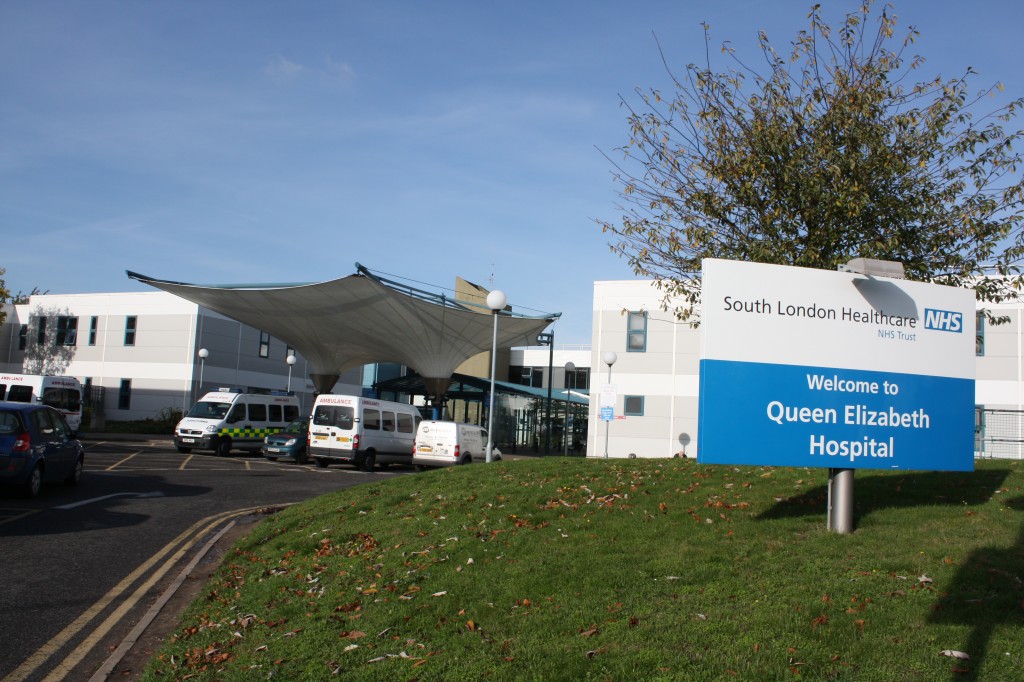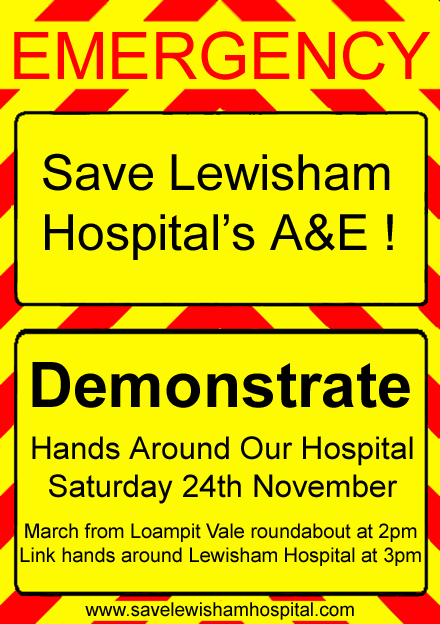
The proposed closure of the Accident and Emergency Department at Lewisham Hospital has provoked the most concern of the proposals in the 373 page draft document from the Office of the Trust Special Administrator (TSA). The document was supposed to address the budget problems of the South London Healthcare NHS Trust, which includes our local Queen Elizabeth Hospital, but has instead addressed the south east London health system as a whole. A campaign to save Lewisham A&E has been started and has held its first meetings; it is organising a “Link Hands Round Lewisham Hospital” protest event to be held on 24th November meeting at 2.00pm in Loampit Vale. A petition supporting Lewisham A&E and maternity services has been started by MP Heidi Alexander. It currently has over 12,000 signatures, and the number is increasing by hundreds every day.
The TSA proposals have been well covered by mainstream media such as BBC News, and local bloggers such as Transpontine, 853 and the Blackheath Bugle. The Bugle includes guidance on how to answer the sometimes leading and sometimes misleading questions in the TSA online response form. For example Question 13 doesn’t explicitly ask if you are in favour of the closure of Lewisham A&E, rather:
Q13. How far do you support or oppose the proposed plans for delivering urgent and emergency care in south east London? The following shows how urgent and emergency care would be delivered:
Emergency care for the most critically unwell – King’s College Hospital, Queen Elizabeth Hospital, Princess Royal University Hospital, St Thomas’ Hospital
Urgent care – Guy’s Hospital, Queen Mary’s Hospital, Sidcup, University Hospital Lewisham
I’ve tried to read the TSA report, but it’s very hard going, full of acronyms and terms that are meaningful to NHS insiders but not to others. It’s disappointing because as a numerate, reasonably well educated person I expect to be able to understand such documents. It’s also full of bean-counter management speak – I lost count of how many times the phrase “financial challenge” was used – and totally based on the concept that the NHS is a market with hospitals represented by a profit and loss account and expected to return a surplus of 1% of their budget each year. Why on earth would a hospital have a surplus – to give it back to George Osborne? And how can a hospital accumulate debt from year to year – the only way it can pay it back is by reducing its spending on treating patients. It’s the kind of approach Michael Sandel criticised in “What Money Can’t Buy: The Moral Limits of Markets” – wider questions aren’t considered, and for a national institution like the NHS, which is part of some of our most painful and saddest and sometimes most joyful experiences, an analysis that considers the beans more than the humans is incomplete.
The data tables in the report contained a few facts that I haven’t seen mentioned elsewhere:
- The TSA is proposing cuts in the numbers of doctors and nurses in the South London Healthcare Trust hospitals – on page 51 it proposes cutting 140 out of 862 doctors and £14m out of the £98m budget for nurses pay. By my reckoning this equates to about 320 nurses losing their jobs, based on the headcount in the Trust’s latest accounts. The accounts also show that they had lost 144, or 6%, of their nursing staff between 2011 and 2012.
- The health budget for south-east London seems to be decreasing in real terms over the next five years – at least that is my reading of the table at the bottom of page 37 – at the same time as the population is expected to grow by 6%. The annual increases on the £3 billion budget are less than 2% a year – less than the rate of inflation and with no allowance for population growth. This when the government has pledged to increase health spending by 1% a year above inflation.
- The income that hospitals receive will decrease each year as a result of a government imposed nation-wide “tariff deflation” of about 1 to 1.5%. The tariff is the amount the hospitals receive for each admission or medical procedure and they are expected to improve efficiency each year to cope with this reduction in their money.
- The justification for recommending Queen Elizabeth Hospital gets an extra £12.2 million a year towards its £33.7 million PFI costs seems to be that QEH spends 16% of its budget on PFI contracts compared to a national average of 10.3%. So the additional money brings the cost to the national average percentage.
I was slightly surprised that health budgets are decreasing – my understanding was that efficiencies are needed because health service inflation is higher than RPI inflation, but I thought that money saved from efficiencies would be used to compensate for this excess inflation. Apparently not – there seems to be less money each year for the next five years.
Another big surprise was the report’s findings about how closing Lewisham A&E would affect the time it would take patients to get to an alternative Accident and Emergency department. It says on page 68:
173. The proposals for emergency care outlined in this draft recommendation would increase the journey time to reach an A&E across south east London by an average of approximately 1 minute for those in an ambulance, 2 minutes for those using private transport and 3 minutes for those using public transport.
Three minutes extra using public transport – I just don’t believe it. Admittedly the report does hedge its bets on travel time – on page 69 it says that public transport travel time for Lewisham residents would be 40.8 minutes, whereas on page 25 of Appendix H it says the incremental travel time from Lewisham to Queen Elizabeth Hospital is 37 minutes by public transport with no traffic.
Overall the impression given by the report is that it is trying to justify its chosen option for the future of the health service in south-east London. The appointment of someone to manage the merger of Lewisham Hospital with Queen Elizabeth before the consultation has completed doesn’t give confidence that our comments will be listened to.

Ploughing through various turgid documents about NHS funding made me wonder how the £105.9 billion NHS budget is distributed to the different areas and hospitals – how is it decided that the NHS in south east London should have £3 billion to spend? Google wasn’t my friend, so I contacted Her Majesty’s Treasury, who replied within a couple of hours saying that I would need to contact the Department of Health for details of the method used to distribute the NHS budget, but pointing me to two documents that might help explain NHS funding.
The first document was A Junior Doctor’s Guide to the NHS, which included the diagram to the right. The DH is the Department of Health, SHA is Strategic Health Authority – in our case London SHA – and PCT is Primary Care Trust – for us this is Greenwich PCT, which controls the budget and commissions services from the NHS Trusts, such as the South London Healthcare NHS Trust that this whole thing is all about. I assume there should be a blue line showing money flowing to the NHS Trusts. I know this is a gross oversimplification, just from the list of different organisations in the TSA report, but it gives the broad flow of money to the hospitals.
Of course it’s already out-of-date because the PCTs will be replaced by GP-led CCGs – Clinical Commissioning Groups – under the current government’s NHS reorganisation.
The second document was the Department of Health Annual Report and Accounts 2011-12 – 230 pages of figures and bean-counter language. However it does include some information about how the NHS budget for different regions (and countries) in the UK is decided. It says on page 61:
A weighted capitation formula determines each PCT’s target share of available resources, to enable them to commission similar levels of health services for populations in similar need, and to reduce avoidable health inequalities. The formula calculates PCTs’ target shares of available resources based on PCT populations adjusted for their age distribution, additional need above that accounted for by age, and unavoidable geographical variations in the cost of providing services.
So broadly it’s based on the number of people who live in an area, how old they are and any special needs – this sounds very like the “health needs target index” mentioned in Appendix H of the TSA report (the Health and Equalities Impact Assessment – scoping report). But it doesn’t say how these factors are taken into account in the distribution, and it only goes to Strategic Health Authority level, i.e. it gives the budget for London but not south east London. Interestingly in 2010/11 the budget for each person in london was the highest in the country at £2163 per person per year.
I’m still waiting to hear from the Department of Health – they give themselves 18 working days to respond to any questions.
If you want to comment on the Trust Special Administrator’s proposals for health care in south east London you can do so using an online response form, by e-mail to tsaconsultation@ipsos-mori.com or by post to Freepost Plus RSHB-CGKA-RYHK, TSA Consultation, Ipsos MORI, Research Services House, Elmgrove Road, Harrow, HA1 2QG. The deadline for submitting comments is midnight on 13th December 2012. There are a series of consultation meetings before then, though the Royal Greenwich website lists more than the OTSA website. The nearest to us are:
- Monday 19 November, 7pm to 9pm: Woolwich Town Hall, Wellington Street, London SE18 6PW
- Wednesday, November 21, 2012 – 10:00 to 12:00 at Greenwich Forum, Trafalgar Road, London, SE10 9EQ
- Monday 26 November, 7pm to 9pm: St Mary’s Community Centre, 180 Eltham High Street, London, SE9 1BJ
- Monday, December 3, 2012 – 19:00 to 21:00 at Charlton Football Club, The Valley, Floyd Road, London’ SE7 8BL
- Tuesday, November 13, 2012 – 19:00 to 21:00 at The Boathouse, Danson Park, Danson Road, Bexleyheath, Kent, DA6 8HL


I got a reply to my questions about how the health budget is divided up from from the Department of Health after just 8 working days. They pointed me to this web page http://webarchive.nationalarchives.gov.uk/+/www.dh.gov.uk/en/Managingyourorganisation/Financeandplanning/Allocations/index.htm
I’m still reading and trying to understand the documents there.